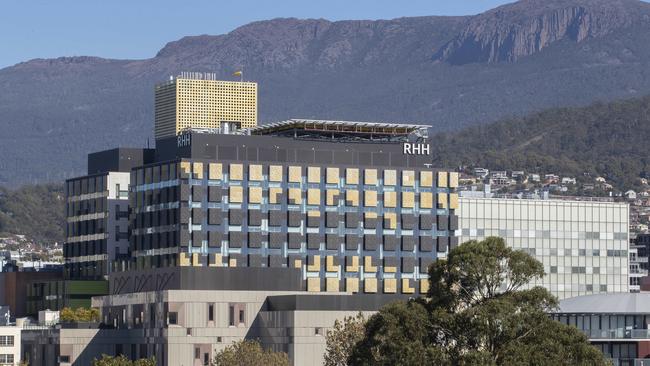Royal Hobart Hospital: Catastrophic swipe access failure ‘compromised’ safety, midwife says
A midwife has accused hospital bosses of downplaying the seriousness of an access swipe system failure she said led to staff being locked in wards and left drug rooms inaccessible, which the department denies.

Tasmania
Don't miss out on the headlines from Tasmania. Followed categories will be added to My News.
An experienced midwife has accused Tasmanian Health Service bosses of downplaying the seriousness of a catastrophic failure of Royal Hobart Hospital’s access swipe system she said led to staff being locked in wards and drug rooms inaccessible.
According to an internal memo distributed to all Hospitals South staff on Friday, seen by the Mercury, the hospital “experienced a technical failure with [its] hospital swipe access system” at approximately 8pm on Thursday.
“This malfunction affected access to several doors within our facilities at the Royal Hobart Hospital and Repatriation [Hospital] sites,” the memo, written by Anna Grady, the hospital’s Nursing Director for Emergency Preparedness and Response, and signed off by acting chief executive Brent Foreman, said.
“Upon identifying the issue, our facilities, engineering, and security services teams were promptly notified.
“Security measures were immediately put into action to ensure that essential areas remained accessible. To maintain unimpeded access across the hospital, we distributed a master key and implemented alternative access solutions where necessary.”

The cause of the system failure had been “thoroughly investigated” and the issue resolved, with Hospitals South now “developing a comprehensive procedure... [to] enhance our preparedness and response capabilities for any similar unforeseen occurrences in the future”.
“I want to clarify and reassure you that at no point was the safety of our patients or staff compromised. The delivery of clinical care continued smoothly throughout this event, without interruption,” the memo said.
However, this was challenged by several Hospitals South staff on an internal messaging platform, Reach.
“The safety of patients and staff WAS compromised,” said a midwife with more than 30 years’ experience.
“Maternity couldn’t access their drug rooms, which meant no lifesaving drugs in the event of a postpartum haemhorrage.
“Staff couldn’t exit the wards, so anyone who needed an urgent caesarean couldn’t be transferred to theatre.
“No exit meant everybody was trapped in the event of a fire, or a code black.
“In addition, no access to drug rooms or S4/S8 [restricted drug] cupboards meant no pain relief for any of our patients.
“Please don’t downplay the seriousness of the situation.”
A female doctor said she agreed with the midwife’s assessment.
“I’m curious what would need to happen for the safety of patients or staff to be compromised. Because the description of what occurred on the ground that night is that of significant compromise to timely patient care and medication access,” she said.
A second doctor, a male, questioned why a ‘code yellow’ – signifying an internal emergency – wasn’t issued.
“We all have a lanyard around our neck every day at work telling us what the emergency codes mean. I’m starting to wonder what it would actually score a code yellow?” he asked.
In a statement provided late on Saturday afternoon, a Department of Health spokeswoman said the incident was mostly resolved by 11.30pm.
She denied staff were unable to exit wards, saying that the issue related to staff being able to enter wards, “which was addressed by accessing emergency entrance devices located outside each ward”.
Access issues with drug rooms were resolved by the security team, who “provided each patient care area with a master key,” she said.
A code yellow did not need to be called because it was “not required”.





